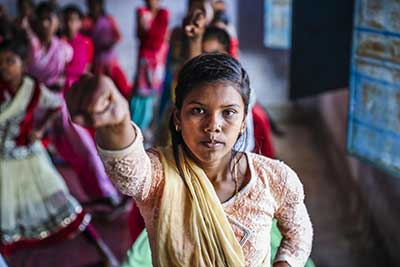Relevance: GS-2: Government policies and interventions aimed at development in various sectors and issues arising out of their design and implementation.
Key Phrases: Intergenerational Cycle of Poverty for Adolescent Girls, Deep-Rooted Mindsets and Discriminatory Societal Norms, Role Models of Local Young Women, National Health Mission, Beti Bachao, Beti Padhao, Poshan Abhiyaan
Why in News?
- The International Day of Action for Women’s Health on 28 May, with its focus on women’s health, sexual and reproductive rights, and socio-emotional health, is a reminder that we must view a woman’s socio-emotional and physical well-being in tandem with the vicious cycle of intergenerational poverty for adolescent girls while looking for solutions.
Key Highlights:
- 23 million girls drop out of school every year when they start menstruating, 102 million girls are married off before the age of 15 (UNICEF, 2019), and 54.1% of adolescent girls, aged 15-19, are anaemic, with a slightly higher incidence in rural areas.
- The millions of girls living in remote, rural, and backward districts of India are not allowed to attend school, married at childhood age, forced to keep doing household chores.
An intergenerational cycle of poverty: A Case Study
- At 16, a school drop-out girl with chronic anaemia gets married to a much older man and becomes a teen mother, most likely with an infant with higher morbidity. It is worse if she delivers a girl child. Existing patriarchal family structures render her with no agency, leaving her at the mercy of her husband and in-laws to take care of her and her child. More often than not, this means she has no voice against domestic violence, discrimination, and lack of opportunities, thereby impacting her daughter too. Thus, the vicious cycle of poverty is inherited by the next generation.
Challenges with Government Programmes:
- The government offers many schemes and beneficial programs, but the beneficiaries usually get stuck in the confusion due to multiple channels and thus, cannot avail of benefits.
- Their reproductive health and access to micronutrients reside with the National Health Mission, vocational skilling with the district’s skilling centre or some NGO running it under a public-private-partnership model, and education with the education department, with their leadership and safety almost nowhere.
- With the capacity and mandate to scale up, the government has launched various flagship programmes, such as Beti Bachao, Beti Padhao, Poshan Abhiyaan, and Rashtriya Kishor Swasthya Karyakram, that focus on the education and health of girls and women. However, the focus of most schemes remains largely on welfare.
Way Forward:
- Multi-Pronged Approach for Sustainable solutions to address
Patriarchy:
- Sustainable solutions to address deep-rooted mindsets and discriminatory societal norms that result in violence against women and perpetuate the poor status of girls and women are not yet in sight.
- These issues can be solved only through collaborative, multipronged approaches.
- All key stakeholders in communities need to collaborate to ensure that their girls have a smooth transition from adolescence to adulthood.
- One-Window Holistic Programme:
- The key to succeeding in empowering adolescent girls is convergence, a one-window holistic program that meets all their development and empowerment needs.
- Hyper-local role models lead the way:
- Various non-government organizations and hyper-local NGOs in districts are innovating with ways to address gender discrimination and create role models of local young women to spark a mindset change within communities.
- Young women from local communities can set new trends for adolescent girls, inspiring them to navigate their own life decisions, such as delaying marriage, accessing vocational skills, and engaging in entrepreneurship.
- This can also ease parental anxiety related to higher education, women being away from home for work, and the likelihood of their elopement, which is a common cause for early marriage, and instead position adolescent girls and women as active contributors to society.
- Participation of Progressive Men:
- To fast-track this shift, it is important to increase the participation of progressive men who want to come forward but lack the support of like-minded peers in a predominantly patriarchal society.
- Such men need to emerge within local communities as advocates of a woman’s fundamental rights, so that young women emerge with the agency to build lives for themselves, and their families, and thus support the nation.
- Leveraging Research for Behaviour Transformation:
- Organizations like International Centre for Research on Women have been conducting research that informs solutions.
- The government and not-for-profit players can leverage research for behaviour transformations across India and implement focused interventions at the last mile.
- The media, with its power of influence, can also use such data to drive the narrative and push for action and change.
Conclusion:
- Poverty and health are crucial factors that impact the economic growth of a country.
- Through the empowerment of adolescent girls, an entire nation can be empowered within this decade.
- We need to change deep-rooted practices that act as barriers and focus all our efforts on a movement in their favour that resonates with the government’s call for “Beti Bachao, Beti Padhao”.
Source: Live-Mint
Mains Question:
Q. An entire nation can be empowered through the empowerment of adolescent girls. Considering this, analyse the challenges associated with their empowerment and suggest measures that aid in their holistic development and growth of the society. (250 words).








